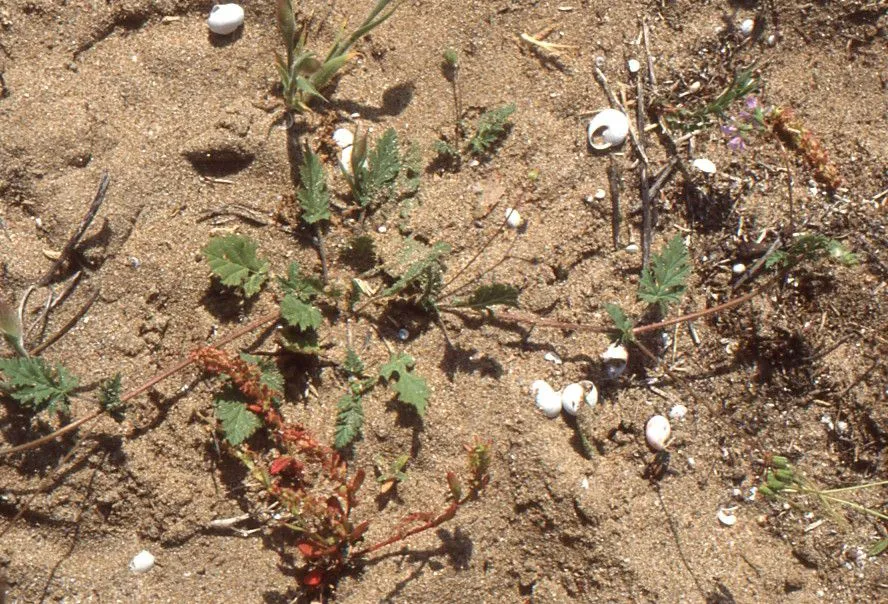
Author: Willd.
Bibliography: Sp. pl. 3(1):633. 1800
Year: 1800
Status: accepted
Rank: species
Genus: Erodium
Vegetable: False
Observations: Canary Is. to SW. Pakistan
Cutleaf stork’s bill, scientifically known as Erodium laciniatum, is a fascinating plant belonging to the Geraniaceae family. This species was first described with botanical authority by Willdenow in the early 1800s, documented in “Species Plantarum” Volume 3, Part 1, on page 633.
Erodium laciniatum displays a unique elegant foliage, often deeply dissected and resembling the form of stork’s bill, from which it derives its common name. This characteristic laciniate leaf structure gives the plant a delicate and intricate appearance, making it an interesting subject for botanists and plant enthusiasts alike.
Geographically, Cutleaf stork’s bill has a broad range, extending from the Canary Islands in the Atlantic to the southwestern regions of Pakistan in South Asia. This wide distribution hints at the plant’s adaptability to a variety of climates and ecological conditions, from temperate zones in the Canary Islands to arid landscapes in Pakistan.
The plant typically thrives in well-drained soils and enjoys sunny locations. It is often found in wild, unmanaged terrains, highlighting its resilience and ability to flourish without much human intervention. As a member of the Geraniaceae family, it shares some traits with other familiar garden geraniums, though its distinct leaf patterns easily set it apart.
Erodium laciniatum carries historical botanical significance due to its early classification and documentation, contributing to the rich tapestry of plant taxonomy and horticultural knowledge. Its presence across such a vast geographical expanse also reflects its vital role in diverse ecosystems, supporting local flora and fauna.
In conclusion, Cutleaf stork’s bill (Erodium laciniatum) is a noteworthy species with its finely cut leaves and expansive habitat range. Celebrated for both its aesthetic appeal and ecological importance, it remains a valuable component of the plant world, illustrating the intricate beauty and adaptability inherent in nature.
Eng: cutleaf stork’s bill
Deu: schlitzblatt-reiherschnabel
Lav: sarmatain
En: Cutleaf stork’s bill, Cutleaf Stork’s-bill, Cutleaf Heron’s-bill
Ar: أبو عقيله (أبوعُقيله)، بخترى (بَخترى), أبو مصفاح (أبومُصفاح)، دهميه (دَهيميه), تمير (تِمِّير، تُمِّير), دهميه غزلان (دَهْميّه غزلان), قرن (قَرْن)، قرنه (قَرْنه)، قرنى (قَرْنى), مرغات (مُرغات)، مرغيث (مِرغيث)
Ca: Cargola laciniada
Fr: Bec-de-grue lacinié, Érodium lacinié, Érodium à feuilles découpées, Bec-de-grue maritime, Erodium maritime
De: Schlitzblatt-Reiherschnabel
He: מקור-חסידה מפוצל
It: Becco-di-grù laciniato
Lv: Sarmatain
© copyright of the Board of Trustees of the Royal Botanic Gardens, Kew.
© copyright of the Board of Trustees of the Royal Botanic Gardens, Kew.
© copyright of the Board of Trustees of the Royal Botanic Gardens, Kew.
Taken Dec 19, 2020 by Mercé Camarasa (cc-by-sa)
Taken Mar 3, 2019 by Jose María Tapiador Fernández (cc-by-sa)
Taken Mar 22, 2018 by Linda Lawliss (cc-by-sa)
Taken Jan 25, 2020 by iannizzotto michele (cc-by-sa)
Taken Apr 16, 2020 by Arroyo Javier (cc-by-sa)
Taken Jan 11, 2020 by Pedro Dias (cc-by-sa)
Taken Apr 21, 2015 by Tela Botanica − Hervé Goëau (cc-by-sa)
Taken May 29, 2014 by Tela Botanica − Liliane Roubaudi (cc-by-sa)
Taken May 29, 2014 by Tela Botanica − Liliane Roubaudi (cc-by-sa)
Taken Apr 29, 2020 by aslı (cc-by-sa)
Taken Feb 1, 2013 by Tela Botanica − Ans GORTER (cc-by-sa)
Taken Apr 20, 2003 by Tela Botanica − Liliane Roubaudi (cc-by-sa)
Taken Apr 21, 2015 by Tela Botanica − Hervé Goëau (cc-by-sa)
Taken Apr 20, 2003 by Tela Botanica − Liliane Roubaudi (cc-by-sa)
Taken May 29, 2014 by Tela Botanica − Liliane Roubaudi (cc-by-sa)
Taken May 29, 2014 by Tela Botanica − Liliane Roubaudi (cc-by-sa)
Taken May 29, 2014 by Tela Botanica − Liliane Roubaudi (cc-by-sa)
Taken May 29, 2014 by Tela Botanica − Liliane Roubaudi (cc-by-sa)
Taken May 29, 2014 by Tela Botanica − Liliane Roubaudi (cc-by-sa)
Taken Apr 21, 2015 by Tela Botanica − Hervé Goëau (cc-by-sa)
Taken Apr 15, 2008 by Photoflora – Benoit BOCK (©)
Taken Apr 15, 2008 by Photoflora – Benoit BOCK (©)
Taken Apr 15, 2008 by Photoflora – Benoit BOCK (©)
Taken Apr 15, 2008 by Photoflora – Benoit BOCK (©)
Taken Jan 1, 1970 by Photoflora – L’Abbé COSTE (©)
Taken Apr 15, 2008 by Photoflora – Benoit BOCK (©)
Taken Apr 21, 2015 by Tela Botanica − Hervé Goëau (cc-by-sa)
Growth habit>: Forb/herb
Family: Myrtaceae Author: (F.Muell.) K.D.Hill & L.A.S.Johnson Bibliography: Telopea 6: 402 (1995) Year: 1995 Status:…
Family: Rubiaceae Author: Pierre ex A.Froehner Bibliography: Notizbl. Bot. Gart. Berlin-Dahlem 1: 237 (1897) Year:…
Family: Sapindaceae Author: Koidz. Bibliography: J. Coll. Sci. Imp. Univ. Tokyo 32(1): 38 (1911) Year:…
Family: Asteraceae Author: A.Gray Bibliography: Pacif. Railr. Rep.: 107 (1857) Year: 1857 Status: accepted Rank:…
Family: Fabaceae Author: Medik. Bibliography: Vorles. Churpfälz. Phys.-Ökon. Ges. 2: 398 (1787) Year: 1787 Status:…
Family: Aspleniaceae Author: (Cav.) Alston Bibliography: Bull. Misc. Inform. Kew 1932: 309 (1932) Year: 1932…